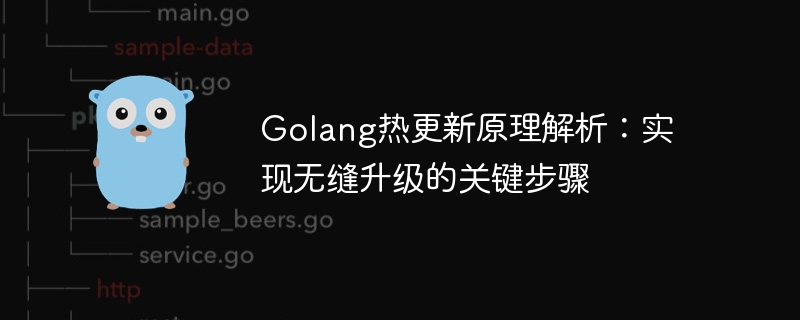

Golang hot update principle analysis: key steps to achieve seamless upgrade, specific code examples are required
Introduction:
With the development of Internet technology and application scenarios With the continuous expansion, high availability and stability have become key issues in software development. In this context, Golang, as a compiled language, is widely used to build high-performance and reliable services. However, with the continuous iteration and upgrade of software functions, hot update has become one of the key solutions to improve system availability and flexibility.
This article will deeply explore the hot update principle of Golang and introduce the key steps to achieve seamless upgrade. At the same time, we will give specific code examples so that readers can better understand and apply these technologies.
1. The basic principle of Golang hot update
Golang’s hot update is based on the principle of code replacement. In the traditional development model, when we upgrade software or iterate functions, we usually need to stop the service, recompile the code, and redeploy, which will lead to service interruption and unavailability. Hot update can dynamically replace the currently running code without stopping the service, thereby achieving functional updates and repairs.
Based on Golang's hot update principle, we can achieve seamless upgrade through the following steps:
Through the above steps, we can implement hot updates of Golang to achieve seamless upgrade effects.
2. Key steps to achieve seamless upgrade
Below, I will use a specific example to show how to implement hot update of Golang. Suppose we have a simple web service that provides an interface to get the current time. We need to upgrade this service to make the time format returned by the interface more friendly.
First, we need to create a new plug-in that contains the new code logic. The plug-in code is as follows:
package main import ( "fmt" "time" ) func GetFriendlyTime() string { return fmt.Sprintf("当前时间:%s", time.Now().Format("2006-01-02 15:04:05")) }
In the original service code, we need to import the new plug-in and replace the code. The code is as follows:
package main import ( "fmt" "plugin" ) type Service interface { GetTime() string } func main() { p, err := plugin.Open("plugin.so") if err != nil { fmt.Println("打开插件失败:", err) return } sym, err := p.Lookup("GetFriendlyTime") if err != nil { fmt.Println("查找符号失败:", err) return } f, ok := sym.(func() string) if !ok { fmt.Println("类型断言失败") return } fmt.Println(f()) }
Through the above code, we can update and upgrade the service. After we compile the new plug-in into an so file, we only need to replace the file in the original service directory and re-run the service. We can see that the interface return time has become more friendly.
3. Summary
Through the analysis of the Golang hot update principle, this article introduces the key steps to achieve seamless upgrade in detail, and gives specific code examples. Through hot update, we can dynamically replace the code without stopping the service to achieve a highly available and flexible system. Of course, hot updates also have certain risks, and you need to pay attention to the robustness and compatibility of the code. Therefore, in practical applications, various factors need to be considered comprehensively to select an appropriate thermal update solution.
The above is the detailed content of Golang hot update: analysis of key steps to achieve seamless upgrade. For more information, please follow other related articles on the PHP Chinese website!
 What are the java testing tools?
What are the java testing tools? The difference between arrow functions and ordinary functions
The difference between arrow functions and ordinary functions Usage of delete statement
Usage of delete statement How to implement h5 to slide up and load the next page on the web side
How to implement h5 to slide up and load the next page on the web side what does focus mean
what does focus mean What are the web servers?
What are the web servers? The difference between external screen and internal screen broken
The difference between external screen and internal screen broken Why is my phone not turned off but when someone calls me it prompts me to turn it off?
Why is my phone not turned off but when someone calls me it prompts me to turn it off?



